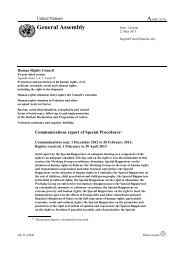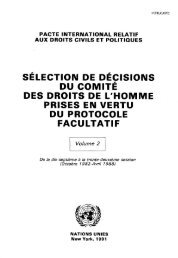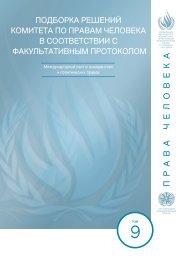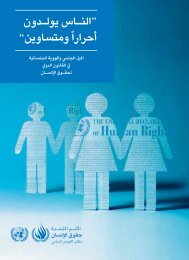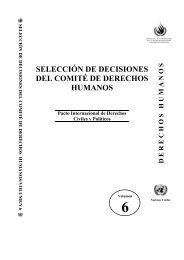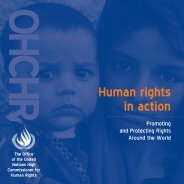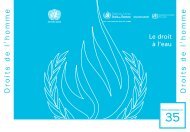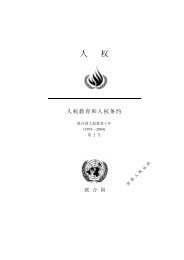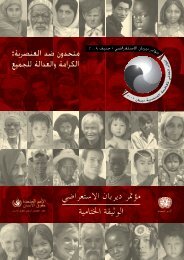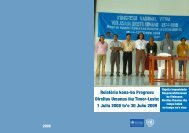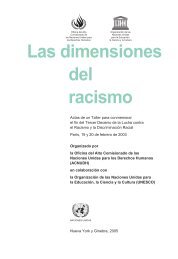good governance practices for the protection of human rights
good governance practices for the protection of human rights
good governance practices for the protection of human rights
You also want an ePaper? Increase the reach of your titles
YUMPU automatically turns print PDFs into web optimized ePapers that Google loves.
One example <strong>of</strong> <strong>the</strong> significant progress in Brazil’s legislation and policy is <strong>the</strong><br />
distribution <strong>of</strong> antiretroviral medicines. The practice began in <strong>the</strong> 1990s and<br />
today over 140,000 patients receive <strong>the</strong> cocktail through <strong>the</strong> public health<br />
system. The Government also started to invest in <strong>the</strong> production <strong>of</strong> antiretroviral<br />
drugs. Currently, <strong>of</strong> <strong>the</strong> 15 medicines that <strong>for</strong>m <strong>the</strong> treatment, 8 are produced in<br />
Brazil.<br />
A shortcoming <strong>of</strong> <strong>the</strong> work <strong>of</strong> <strong>the</strong> Parliamentary Group is that it is affected by <strong>the</strong><br />
election calendar and <strong>the</strong> re-election <strong>of</strong> its members. It may <strong>the</strong>re<strong>for</strong>e be important<br />
to streng<strong>the</strong>n <strong>the</strong> parliamentary civil service supporting <strong>the</strong> Group’s work in<br />
order to ensure continuity.<br />
F. Promoting <strong>the</strong> political participation <strong>of</strong> indigenous groups<br />
and managing conflict – Norway<br />
Issue<br />
The Sami are an indigenous people who live in <strong>the</strong> polar regions <strong>of</strong> nor<strong>the</strong>rn<br />
Norway, Sweden, Finland and <strong>the</strong> Kola Peninsula in <strong>the</strong> Russian Federation. The<br />
size <strong>of</strong> <strong>the</strong> Sami population has been estimated at 75,000–100,000, <strong>of</strong> whom<br />
about 40,000–45,000 live in Norway. The Norwegian Government’s policy toward<br />
<strong>the</strong> Sami in <strong>the</strong> 1970s focused on socio-economic policies and regional<br />
development. However, it did not address Sami political representation or <strong>the</strong><br />
preservation <strong>of</strong> <strong>the</strong> Sami language and culture. In <strong>the</strong> 1970s, civil disobedience<br />
by Sami activists in response to <strong>the</strong> Government’s policy decisions and a<br />
confrontational atmosphere in <strong>the</strong> relations between <strong>the</strong> Sami community and<br />
<strong>the</strong> Norwegian Government pointed to <strong>the</strong> need <strong>for</strong> collaborative strategies to<br />
design policies which satisfied <strong>the</strong> <strong>rights</strong> and needs <strong>of</strong> <strong>the</strong> Sami.<br />
Response<br />
Through <strong>the</strong> establishment <strong>of</strong> <strong>the</strong> Sami Parliament (Sámediggi) in 1989, <strong>the</strong> representatives<br />
<strong>of</strong> <strong>the</strong> Sami and <strong>the</strong> Norwegian Government attempted to balance<br />
two <strong>of</strong>ten competing demands related to <strong>the</strong> self-determination <strong>of</strong> indigenous<br />
people. The first is that indigenous people should have <strong>the</strong> right to define and<br />
<strong>for</strong>mulate <strong>the</strong>ir own public policy agenda. The second relates to <strong>the</strong> need to respect<br />
<strong>the</strong> democratic process and State institutions, and <strong>the</strong> principle <strong>of</strong> equality<br />
<strong>of</strong> all citizens. As a result, <strong>the</strong> Sámediggi relies on dialogue and cooperation<br />
with <strong>the</strong> Norwegian State in order to protect <strong>the</strong> culture and lifestyle <strong>of</strong> <strong>the</strong> Sami<br />
within <strong>the</strong> framework <strong>of</strong> <strong>the</strong> Norwegian political system. Its success stems from<br />
<strong>the</strong> willingness <strong>of</strong> both <strong>the</strong> representatives <strong>of</strong> <strong>the</strong> Sami people and those <strong>of</strong> <strong>the</strong><br />
Norwegian Government to debate and discuss be<strong>for</strong>e designing public policies.<br />
The Sámediggi was established as an independent institution elected by and<br />
among <strong>the</strong> Sami. It was designed to advise <strong>the</strong> central authorities on issues pertaining<br />
to <strong>the</strong> Sami people, and to carry out a number <strong>of</strong> policies, including education,<br />
culture, language, environment and economic development policies.<br />
23



